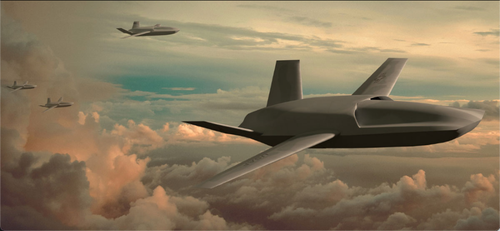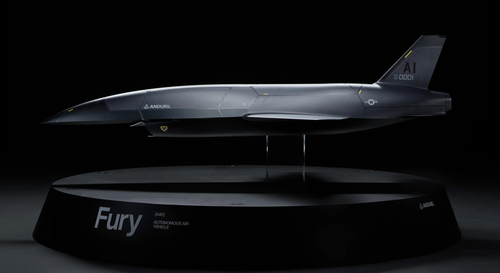
The US Air Force's hot pursuit of drone wingmen, known as collaborative combat aircraft, flying alongside piloted stealth fighter jets such as the Lockheed Martin F-35 Lightning II and Lockheed Martin F-22 Raptor, is a major effort to modernize its fleet and advance defensive and offensive capabilities in a world erupting into chaos.
On Wednesday, the USAF announced that Palmer Luckey's defense tech startup Anduril and General Atomics Aeronautical Systems were selected to build and test wingmen drones for the next phase of the CCA program. This means the pool of competitors has shrunk from five to two, eliminating Boeing, Lockheed Martin, and Northrop Grumman. We don't think the military is ready for 737 Max drones.
"The companies not selected to build these production representative CCA vehicles, and execute the flight test program, will continue to be part of the broader industry partner vendor pool consisting of more than 20 companies to compete for future efforts, including future production contracts," the service wrote in a press release.
USAF wants to deploy more than 1,000 wingmen drones that can carry out a wide range of missions, including electronic warfare, intelligence, surveillance, reconnaissance, and dogfighting.
Commenting on the announcement, Secretary of the Air Force Frank Kendall said the CCA started "just over two years ago" as part of his "Operational Imperatives, to pursue collaborative combat aircraft."
"The progress we've made is a testament to the invaluable collaboration with industry, whose investment alongside the Air Force has propelled this initiative forward. It's truly encouraging to witness the rapid execution of this program," Kendall said.
General Atomics has pitched the Air Force on its autonomous collaborative drone known as "Gambit."
While Anduril has submitted a high-performance autonomous air vehicle called "Fury."
"There is no time to waste on business as usual," Anduril chief executive Brian Schimpf said in a release, adding, "With the CCA program, Sec. Kendall and the Air Force have embraced a fast-moving, forward-looking approach to field autonomous systems at speed and scale. ... Anduril is proud to pave the way for other non-traditional defense companies to compete and deliver on large-scale programs."
We've been saying for years that the next major conflict will be fought with hypersonic weapons and drones. And that's precisely the technology being used in Ukraine.
Luckey's startup, Anduril, aims to cement America's lead in the military technology race, as the bloated military-industrial complex risks blowing the lead.
"We need a new breed of defense technology companies to reboot the arsenal of democracy," Anduril states on its website.
The US Air Force’s hot pursuit of drone wingmen, known as collaborative combat aircraft, flying alongside piloted stealth fighter jets such as the Lockheed Martin F-35 Lightning II and Lockheed Martin F-22 Raptor, is a major effort to modernize its fleet and advance defensive and offensive capabilities in a world erupting into chaos.
On Wednesday, the USAF announced that Palmer Luckey’s defense tech startup Anduril and General Atomics Aeronautical Systems were selected to build and test wingmen drones for the next phase of the CCA program. This means the pool of competitors has shrunk from five to two, eliminating Boeing, Lockheed Martin, and Northrop Grumman. We don’t think the military is ready for 737 Max drones.
“The companies not selected to build these production representative CCA vehicles, and execute the flight test program, will continue to be part of the broader industry partner vendor pool consisting of more than 20 companies to compete for future efforts, including future production contracts,” the service wrote in a press release.
USAF wants to deploy more than 1,000 wingmen drones that can carry out a wide range of missions, including electronic warfare, intelligence, surveillance, reconnaissance, and dogfighting.
Commenting on the announcement, Secretary of the Air Force Frank Kendall said the CCA started “just over two years ago” as part of his “Operational Imperatives, to pursue collaborative combat aircraft.”
“The progress we’ve made is a testament to the invaluable collaboration with industry, whose investment alongside the Air Force has propelled this initiative forward. It’s truly encouraging to witness the rapid execution of this program,” Kendall said.
General Atomics has pitched the Air Force on its autonomous collaborative drone known as “Gambit.”
While Anduril has submitted a high-performance autonomous air vehicle called “Fury.”
“There is no time to waste on business as usual,” Anduril chief executive Brian Schimpf said in a release, adding, “With the CCA program, Sec. Kendall and the Air Force have embraced a fast-moving, forward-looking approach to field autonomous systems at speed and scale. … Anduril is proud to pave the way for other non-traditional defense companies to compete and deliver on large-scale programs.”
We’ve been saying for years that the next major conflict will be fought with hypersonic weapons and drones. And that’s precisely the technology being used in Ukraine.
Luckey’s startup, Anduril, aims to cement America’s lead in the military technology race, as the bloated military-industrial complex risks blowing the lead.
“We need a new breed of defense technology companies to reboot the arsenal of democracy,” Anduril states on its website.
Loading…






